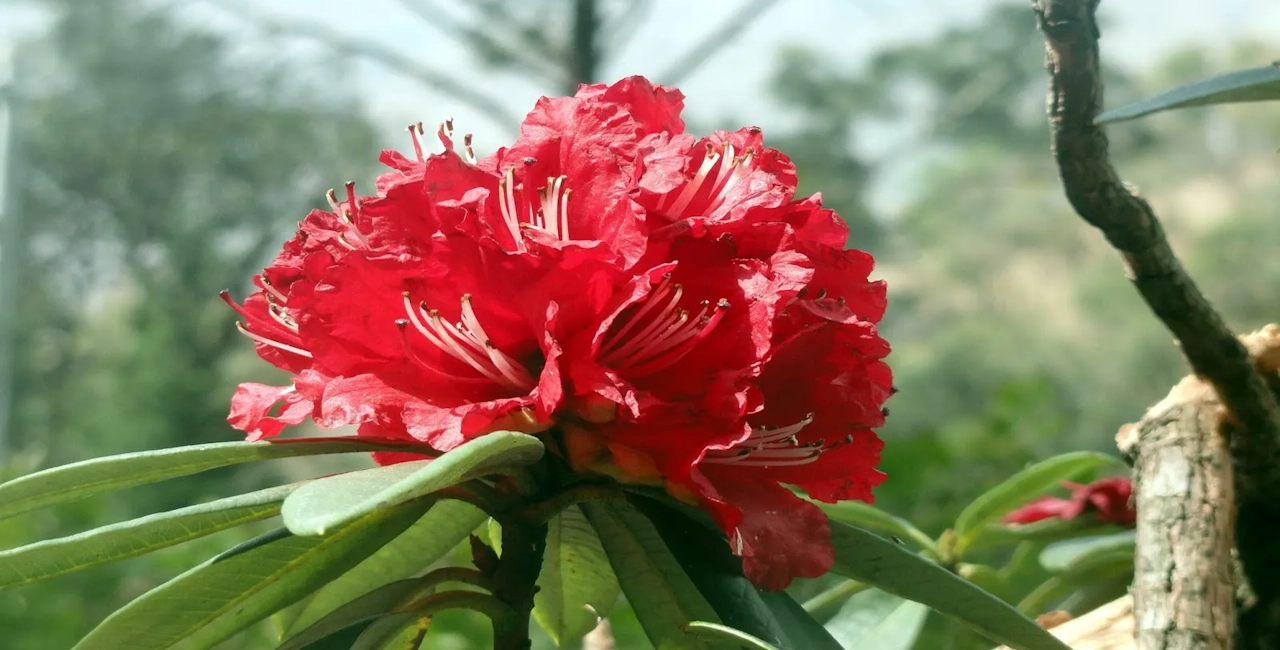Currently Empty: ₹0.00

Burans, known scientifically as Rhododendron arboreum, is more than just a vibrant flowering tree. Found abundantly in the Himalayan region, this species of rhododendron is celebrated for its striking red blooms and its cultural, medicinal, and ecological significance. Often referred to as the “Flame of the Forest,” Burans holds a special place in the hearts and lives of the people living in the hilly terrains of India, Nepal, and Bhutan.
A Splash of Scarlet Across the Hills
The Burans tree transforms the rugged Himalayan landscape into a canvas of red during its blooming season, typically between February and April. The flowers, with their bell-shaped structure and vivid hues ranging from deep crimson to pink, are a sight to behold. These blossoms attract not only nature enthusiasts but also birds, bees, and other pollinators, making Burans a crucial part of the mountain ecosystem.
This flowering tree thrives at altitudes ranging from 1,200 to 3,600 meters and prefers cool, moist climates. Its dense foliage and tall stature, which can reach up to 15 meters, make it a dominant species in its habitat.
Cultural Significance
Burans is deeply woven into the cultural fabric of the Himalayan communities. In Uttarakhand and Himachal Pradesh, the flower is not just admired for its beauty but also revered in local traditions and rituals. During festivals and special occasions, Burans flowers are often used as offerings in temples.
The flower is also a symbol of prosperity and love, appearing in folk songs and regional literature. Its vivid red color is believed to represent vitality and passion, adding a touch of mysticism to its cultural importance.
Medicinal Properties and Health Benefits
Beyond its aesthetic appeal, Burans is celebrated for its medicinal properties. The flowers are used to prepare a variety of traditional remedies. Burans juice, made by extracting the nectar from its petals, is a popular drink in the Himalayan region. Known for its tangy taste and deep red color, this juice is believed to have numerous health benefits, including:
- Heart Health: Burans juice is rich in antioxidants and has been linked to improved cardiovascular health by reducing cholesterol levels and improving blood circulation.
- Anti-inflammatory Properties: The juice and extracts from the flower are used to alleviate inflammation and joint pain, particularly in cases of arthritis.
- Digestive Aid: Consuming Burans juice is said to help with digestion and reduce acidity.
- Energy Booster: Its revitalizing properties make it a natural energy drink for people living in high-altitude areas.
The flower’s medicinal value has also caught the attention of modern herbal medicine practitioners, further cementing its reputation as a “healing flower.”
Ecological Importance
The Burans tree plays a vital role in the Himalayan ecosystem. Its flowers are an essential food source for various pollinators, including bees and butterflies. Additionally, the tree’s dense canopy helps prevent soil erosion, a common issue in mountainous regions.
The fallen flowers decompose to enrich the soil, enhancing its fertility and promoting the growth of other plants. This makes Burans an integral part of maintaining ecological balance in its native habitat.
Culinary Delights
In addition to its medicinal uses, Burans has found its way into the kitchens of the Himalayan communities. The flowers are used to make syrups, jams, and chutneys. Burans juice, a staple in the region, is often served to guests as a gesture of hospitality. Its unique flavor profile, combining tartness with a hint of sweetness, makes it a refreshing treat.
Threats and Conservation Efforts
Despite its many benefits, the Burans tree faces threats from deforestation, climate change, and over-harvesting of its flowers. These factors have led to a decline in its population in certain areas.
Efforts are underway to conserve this valuable species. Local governments and environmental organizations are working to raise awareness about sustainable harvesting practices and the importance of preserving Burans trees. Community-led initiatives, including reforestation programs and eco-tourism, are playing a significant role in protecting this natural treasure.
Conclusion
Burans is much more than a tree with beautiful flowers; it is a symbol of life, health, and cultural identity for the Himalayan people. Its striking beauty, combined with its ecological and medicinal significance, makes it a cornerstone of the region’s natural and cultural heritage. As efforts to conserve and celebrate Burans continue, this vibrant flame of the forest will undoubtedly remain a source of inspiration and sustenance for generations to come.


